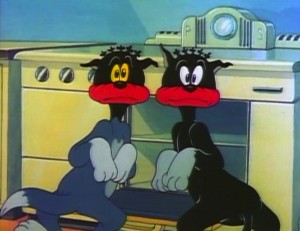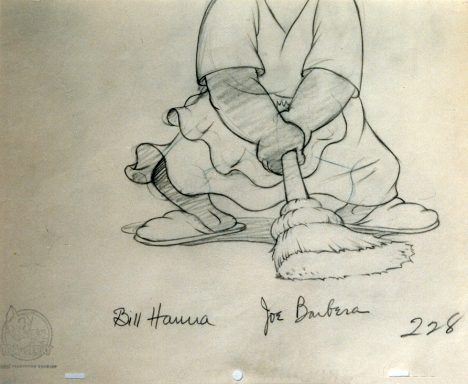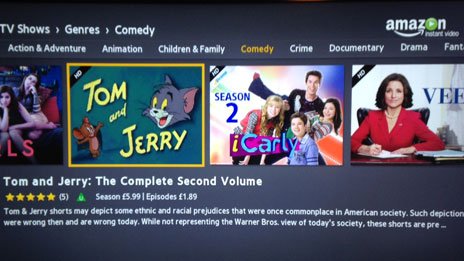Amazon Prime and iTunes have included a warning with their packaging of Tom and Jerry – Metro-Goldwyn-Mayer’s series of theatrical cartoons starring Tom Cat and Jerry Mouse. From 1940 to 1952, an African American female domestic servant appeared in episodes, and in that period the characters often appeared in blackface. These images undoubtedly are the reason why the warning says that the cartoons may contain “ethnic and racial prejudices that were once commonplace in American society.”
The warning has its detractors. Some of them find the disclaimer unnecessary because to them Tom and Jerry is not racist, and others dismiss the warning as another example of contemporary excessive political correctness. The problem is that detractors are using personal feelings to try to stop a potentially useful discussion about ethnic depictions in American entertainment. Their knee-jerk “It’s not racist” and “liberal political correctness” reactions are only opinions that disregard the facts concerning the cartoons.
In my book The Colored Cartoon: Black Presentation in American Animated Short Films, 1907-1954, I chronicled the servant character’s development from her debut to her final episode. I noted that in her twelve years in the series, MGM never changed her dialect. The writers of the scripts gave her the same mis-conjugated verbs and spelled her mispronounced words exactly the same throughout that period, refusing to develop her at all. Also, none of the scripts give the character a name. She is the “maid” or “colored maid,” and the denial of an identity is part of her lack of development over a decade’s time.
I also looked at the blackface scenes in MGM’s cartoons, most of which have a character darkened after an explosion. Again, the scripts are stereotypically charged, using phrases like “looking like a pickaninny” and walking “a la Stepin Fetchit.” Thus, the MGM artists made these cartoons with ethnic jokes at African Americans’ expense very much in mind. Even one of the series’ animators I interviewed called the maid an “outright racist cartoon character.”

As for the cries of modern political correctness, it’s not that modern. In my book I note that civil rights groups protested the showing of Tom and Jerry episodes in theaters as early as 1949. They claimed that the exhibitions of the maid character harmed the minds of children, and they occasionally convinced theater-owners to withdraw the cartoons.
Such protests became so impactful to Hollywood that MGM eventually became proactive about the maid. The studio reanimated the 1948 episode The Little Orphan in wide-screen format as Feedin’ the Kiddie in 1957. The original episode featured the maid, but the remake omitted her entirely. Then in 1965, MGM prepared the series for Saturday morning network television by reanimating all of the maid’s appearances. The studio replaced her with a European American maid character in all of her scenes. In recent years, the original scenes returned for cable television broadcast on Cartoon Network and Boomerang, bur MGM overdubbed Lillian Randolph’s stereotyped vocal performance with Thea Vidale’s dialect-free delivery.
The 2014 warning is just the latest attempt to make Tom and Jerry commercially viable in a changing ethnic American landscape. The disclaimer is a new approach in that it does not censor or gloss over but instead informs. It allows an opportunity for education about the films, while the detractors get to enjoy the uncensored original episodes.
Does the warning do enough to address the ethnic content of the series? Are other solutions besides disclaimers possible?



I guess I shouldn’t be surprised that folks are complaining that the warning is PC, but I was a bit. I guess there’s just a very strong resistance to ever acknowledging racism in anything, in some circles. Anti-anti-racism is the new racism.
I just don’t want a blanket racism warning on the entire series. If they only slap it on the episodes with racist elements, that’s fine.
“The problem is that detractors are using personal feelings to try to stop a potentially useful discussion about ethnic depictions in American entertainment. ”
Is a disclaimer really a discussion, though?
WARNING: THE ABOVE BLOG POST AND/ OR COMMENT SECTION MAY CONTAIN OPINIONS YOU DISAGREE WITH. READER DISCRETION IS ADVISED.
Pallas, I think the point is that a disclaimer is a way to point out that there needs to be a discussion. It’s acknowledging there’s a legitimate issue. Your disclaimer there seems too general to serve that function; pointing to racism in particular seems like it’s a bit different.
I think it’s likely that a lot of people only remember the Tom and Jerry cartoons in circulation in the 1980s and are not remembering the maid.
That said I don’t think Tom and Jerry is funny or interesting in and of itself. Should’ve had a “this sucks” warning on the box too.
I guess I sort of agree that a label acknowledges there’s a legitimate issue, but on the other hand there’s something a little funny about the idea that a disclaimer solves a problem of a racist children’s cartoon being distributed where children will view it in 2014.
I mean, it seems the argument is that we’re all a little smarter and wiser because of the warning label, then? And more warning labels for fiction would be a good thing? I’m just finding that a bit funny.
Presumably the label is for the benefit of parents, no?
“Before plopping your child in front of the one-eyed babysitter for 4 hours, please be advised that there might be some stuff that offends you here.”
“Oh, in that case I’ll pick another program, thanks.”
I imagine the real purpose of the warning is to deflect any accusations that the company is racist for publishing a racist cartoon. (I’m not saying they shouldn’t publish it, just that the whole thing is a bit silly)
Incidentally the only warning on the blue ray package is that the package “is intended for the adult collector and may not be suitable for children”
There isn’t even a racism warning on the blue ray package:
http://www.amazon.com/gp/product/B0058O1FHK/ref=s9_simh_gw_p74_d0_i1?pf_rd_m=ATVPDKIKX0DER&pf_rd_s=center-2&pf_rd_r=04ZESE6FNGDM498SZNC6&pf_rd_t=101&pf_rd_p=1688200382&pf_rd_i=507846
That said, publishing those disclaimers may in fact be the least bad option out of several bad options.
I’m really intrigued by the fact that viewers have been voicing their objections to the racial images in the cartoon since 1949. For me it calls into question the concerns about how such a disclaimer disingenuously applies contemporary values to “another time.” Certainly the consequences of airing episodes with the maid and characters in blackface are greater today than they were back then. But widely practiced doesn’t mean widely accepted.
Thanks to Boomerang though, I think a lot of younger viewers – including my own 8 yr old daughter who absolutely *loves* Tom & Jerry – don’t know about the offensive images in these older episodes. Growing up, I only saw them occasionally myself (but enough to cringe when my daughter started showing an interest in the show). So I think that the disclaimer is a decent attempt at making viewers aware of the content. I might even be okay with the warning being placed on individual episodes if so many of these streaming sites didn’t have the autoplay feature that lets you view an entire season without stopping.
“I’m really intrigued by the fact that viewers have been voicing their objections to the racial images in the cartoon since 1949. For me it calls into question the concerns about how such a disclaimer disingenuously applies contemporary values to “another time.” Certainly the consequences of airing episodes with the maid and characters in blackface are greater today than they were back then. But widely practiced doesn’t mean widely accepted.”
This is an interesting thing to think about. I recall a Gene Deitch interview where he talked about his stint working in Tom & Jerry and he was initially reluctant to work on the series because he had a problem with the racist depiction of the maid as well as the way it glorified violence. That would have been the early 60s but Deitch is someone who had worked in the animation industry since the 1940s.
I have no problem with the disclaimer as it is, but I’d be fine with a warning just for the episodes with the maid and blackface. That way the episodes without the maid and blackface would not be subject to the same warning.
This disclaimer is just boilerplate; comic reprints do it too — some of Tezuka’s work, the Mickey Mouse strips from Fantagraphics (where it really is necessary — yowza), I think some of the DC cheapo Showcase reprints (Lois Lane, oy)…John’s right that it’s, if nothing else, a useful note for parents. I wish they had disclaimers like that for retrograde gender stuff in contemporary kids’ entertainment.
This struck me, tho: “The studio replaced her with a European American maid character in all of her scenes”. Is anyone else creeped out by that? Not because of any bs about it spoiling the original artistic vision; it just seems like that’s maybe even worse, effacing the presence at all of a person of colour. I feel the same way about when Eisner replaced Ebony White with a white guy (Sammy?) who looked basically the same, only white. But I don’t know the first thing about identity politics, so…
This happened with Tintin too; black stereotypes replaced by Arab stereotypes
https://www.hoodedutilitarian.com/2011/07/can-the-subaltern-draw-the-case-of-the-arab-henchman/
Progress!
I can’t remember if this was already discussed on HU — I suspect it was — but Warner Brothers did something similar, but more elaborate for its Looney Tunes collections. They hired Whoopi Goldberg to do an intro that explains what MGM’s label does. She also says that WB thought about cutting the objectionable segments, but thought that preserving the integrity of the cartoons and using them as a starting point for discussion was a better option.
My local Disney maven says that Disney has a more hamfisted solution. They cut a similar bit out of Fantasia and refuse to let Song of the South see the light of day, even though it’s arguably considerably less objectionable than the maid in Tom & Jerry.
I saw the unlabeled maid and blackface bits on T&J in the eighties, which is kind of stunning when you think about it. Unlike the rest of T&J’s slapstick, the jokes don’t really translate, though. As derogatory depictions of African Americans, they were very much of their time. They not only didn’t resemble the black people I knew as a kid, they didn’t resemble the contemporary racist depictions, either.
Just want to chime in here on one little point: while many assume the black woman to be a maid based on the way she dresses, one could still also argue that she is, in fact, the owner of the house. Not once in any of the cartoons is there mention of any other owners and she frequently refers to the house as “MY house.” (Although one could read that as simply taking ownership of her job as a maid). Further observations can be made about the numerous shorts that take place at night, where the woman is clearly the only human in the house.
That said, there’s certainly enough racially offensive humour in T&J (and Hanna Barbera cartoons in general) to write a whole book about, but there’s enough vagueness about the black woman’s status in the cartoons to argue either way.
It should also be noted that Hanna Barbera’s theatrical shorts still used blackface gags long after Warner Brothers begun to phase them out. By the mid 40s, blackface gags in Warner Brothers cartoons were quite rare, but Hanna Barbera used them as late as the 1950s.
Sorry, just a minor correction to the above post–I should have called them MGM/HB instead of Hanna Barbera, which didn’t officially become their “name” brand until their work in television.
To IIj’s point about the maid character, as a kid I defintely thought she was the owner. I didn’t yet know the stereotype, so it was the only reasonable interpretation for me, at the time. However, I saw it as a teenager when my youngest brother was watching T&J re-runs. At that point, I had no doubt she was supposed to be the maid. When I pointed this out to my mom she looked shocked, (not by the stereotype, which she recognized as racist), but by the fact that she had allowed me to watch T&J at all.
Anyway, the Goldberg solution strikes me as a super reasonable way to deal with this sort of iconography. If you simply scrub it or denounce it you aren’t really dealing with it, or its legacy. Better to make use of it.
Too bad the racist 40’s and 50’s Tom & Jerry episode are far supervisor to the 60’s and 70’s ones. I’ve seen them since I was a kid on Cartoon Network and later Boomerang and the art and visual gags were noticeable better. I don’t recall seeing the blackface episodes though so maybe they took the most offensive ones out of circulation.
I do appreciate this: the idea of sweeping this sort of thing under the rug doesn’t seem right – acknowledging this (or better yet, starting a discussion) would be actually proactive, and it’s nice that MGM is willing to air their uncensored dirty laundry like this.
However, I can totally see why others aren’t so cool with just slapping a disclaimer on a product that will mostly appeal to children and calling it a day.
But then we’re talking about censorship and what’s appropriate to spark a conversation with your child about this sort of thing, which is a whole other kettle of fish.
Overall, though, kudos to MGM for neither ignoring the issue or burying it. WB sound like they’ve got the best idea by prefacing these things, but I still find this commendable.
T&J’s both very interesting & very funny!